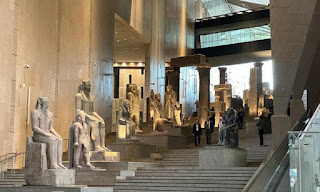Continuing our coverage of important national events, perhaps the most important of which is the opening of the Grand Egyptian Museum,
Visitors to the new Egyptian Museum will be able to see many things for the first time, not found in any other museum in the world, including:
The Grand Staircase
 |
| The Grand Staircase at the Grand Egyptian Museum |
It is a staircase that displays a variety of artifacts that belong to the era of the Old Kingdom and up to the Greco-Roman era, according to the chronological order of these unique pieces.
Hanging obelisk
 |
| The hanging obelisk at the Grand Egyptian Museum |
The Hanging Obelisk is a slender, four-sided stone column with a square base and a small pyramid at its top. This was a feature of ancient Egyptian civilization. Its sides were carved with hieroglyphic inscriptions and royal and religious symbols. The design of the Hanging Obelisk site allows visitors to walk on a glass floor, allowing them to see the underside of the obelisk's base for the first time, If the visitor looks up, he will see, at a distance of 3 meters, the cartouche of King Ramses, which appears below the base of the obelisk suspended on four columns. This is considered the first time that the original archaeological base of the obelisk has been displayed, which no one has noticed in all the obelisk squares in the world.
Source:
















